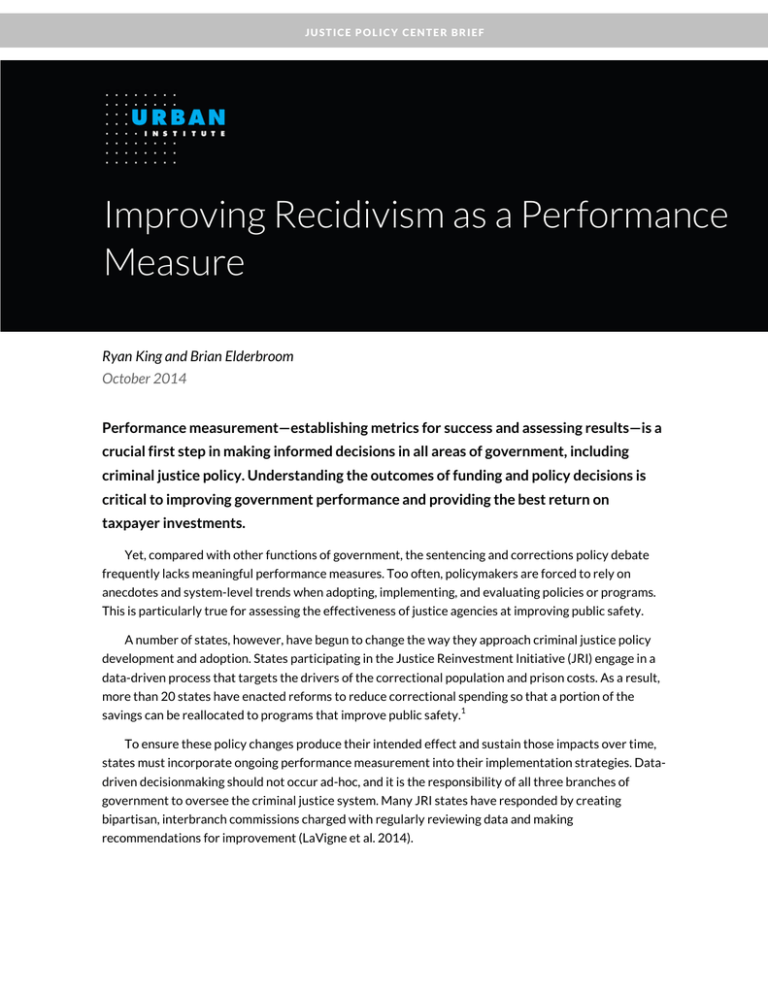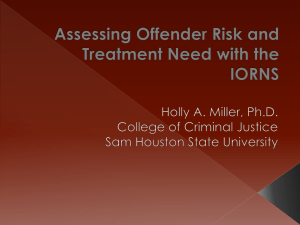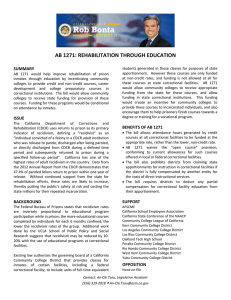Improving Recidivism as a Performance Measure
advertisement

JUSTICE POLICY CENTER BRIEF Improving Recidivism as a Performance Measure Ryan King and Brian Elderbroom October 2014 Performance measurement—establishing metrics for success and assessing results—is a crucial first step in making informed decisions in all areas of government, including criminal justice policy. Understanding the outcomes of funding and policy decisions is critical to improving government performance and providing the best return on taxpayer investments. Yet, compared with other functions of government, the sentencing and corrections policy debate frequently lacks meaningful performance measures. Too often, policymakers are forced to rely on anecdotes and system-level trends when adopting, implementing, and evaluating policies or programs. This is particularly true for assessing the effectiveness of justice agencies at improving public safety. A number of states, however, have begun to change the way they approach criminal justice policy development and adoption. States participating in the Justice Reinvestment Initiative (JRI) engage in a data-driven process that targets the drivers of the correctional population and prison costs. As a result, more than 20 states have enacted reforms to reduce correctional spending so that a portion of the 1 savings can be reallocated to programs that improve public safety. To ensure these policy changes produce their intended effect and sustain those impacts over time, states must incorporate ongoing performance measurement into their implementation strategies. Datadriven decisionmaking should not occur ad-hoc, and it is the responsibility of all three branches of government to oversee the criminal justice system. Many JRI states have responded by creating bipartisan, interbranch commissions charged with regularly reviewing data and making recommendations for improvement (LaVigne et al. 2014). Four Steps to Make Recidivism a Meaningful Performance Measure 1. Definition: Use multiple measures of success. 2. Collection: Develop protocols to ensure data are consistent, accurate, and timely. 3. Analysis: Account for the underlying composition of the population. 4. Dissemination: Package the findings to maximize impact and get the results into the hands of decisionmakers. Recidivism, the most commonly used definition of correctional success, is one example of a performance measure that many states use. Broadly defined as reengaging in criminal behavior after receiving a sanction or intervention, recidivism is an important performance measure for justice agencies and should be at the heart of any effort to evaluate JRI outcomes. Unfortunately, recidivism is most frequently reported as a single, statewide rate, which is too imprecise to draw meaningful conclusions and insufficient for assessing the impact of changes to policy and practice. Outlined below are necessary elements that every state should be using when defining, collecting, analyzing, and disseminating recidivism data. The specific metrics will vary from state to state, but a blueprint exists for expanding beyond system-level trends, accurately comparing across groups and over time, and using the results to inform decisionmaking and improve outcomes. This policy brief lays the groundwork and sets the stage for the next generation of recidivism research. Definition: Use Multiple Measures of Success One of the most common ways that states measure recidivism is to assess whether a person returns to prison within three years of release. The first step in making recidivism a meaningful performance measure is to move beyond the idea of a single measure of success or failure. There is no “right” measure of recidivism. Instead, states should think of recidivism as a series of different performance indicators that must be carefully calibrated to the outcome they are intended to measure. Recidivism reduction is the responsibility of multiple agencies and many different actors, and the definition of success must allow for a range of outcome measures that are responsive to this fact. For starters, more states should ensure that their recidivism measures encompass multiple public 2 safety indicators. For example, the US Bureau of Justice Statistics’s landmark national reports on the recidivism rates of 1983, 1994, and 2005 prison release cohorts measure recidivism as a rearrest, 3 reconviction, reincarceration for a new crime, or return to prison. Individuals should also be tracked for at least three years after release or longer, as longer observation periods provide valuable information on the link between supervision length and rates of reoffending. Though failure rates should serve as the foundation of recidivism research, it is critical to move beyond them to improving recidivism as a performance measure. To improve descriptive reporting of 2 IMPROVING RECIDIVISM AS A PERFORMANCE MEASURE recidivism, states should also include desistance, time to failure, crime severity, and behavior changes as indicators of success. Desistance: How Many People Released from Prison Never Return? In addition to recidivism (failure), states should also measure desistance (success) following a first-time felony conviction and prison sentence. Traditional recidivism rates disproportionately include people with longer criminal histories who “churn” in and out of the system and drive up the rates. An additional desistance measure that tracks the rate of return only for people following their first release from prison answers a different, important policy question about prison as an intervention. Time to Failure: How Long Do People Released from Prison Remain Crime Free? Though indisputably important, binary measures of recidivism (success or failure) tell an incomplete story. Increasing the duration between criminal offending is a positive outcome, and officials should be collecting the data necessary to evaluate correctional interventions on this metric. Figure 1, from the Delaware Criminal Justice Council’s 2013 report on recidivism, is an example of how to measure time to failure. FIGURE 1 Measuring Time to Failure in Delaware Percent 80 2008 2009 2010 70 60 50 40 30 20 10 0 6 12 18 24 30 36 Months from at-risk date Sources: Delaware Criminal Justice Council and Statistical Analysis Center, An Analysis of Prisoners Released in 2008 and 2009 (Wilmington: Delaware Criminal Justice Council and Statistical Analysis Center, 2013); 2010 data from personal correspondence. Note: Failure here indicates an arrest. IMPROVING RECIDIVISM AS A PERFORMANCE MEASURE 3 Severity: Are the Crimes of Those Who Reoffend Less or More Severe than Their Previous Offenses? Desistance from all future criminal offending is the most desirable outcome, but preventing more serious crimes is a positive public safety impact that should be measured. Specifically, states should compare the severity of the prior offense that led to imprisonment with any post-release criminal offending. Table 1, from the Pennsylvania Department of Corrections 2013 report on recidivism, is an example of how to measure the severity of reoffending. TABLE 1 Pennsylvania Rearrest by Commitment and Crime Types For Pennsylvania prison inmates released in 2008, three-year follow-up (percent) Rearrest crime type Crime type for original commitment Violent Property Drugs Public order/other Violent Property 13.1 7.1 7.3 7.7 9.0 24.7 8.0 11.2 Drugs 10.4 9.0 22.4 12.3 Public order/other 12.7 11.9 12.8 16.8 No rearrest 54.8 47.3 49.4 52.1 Source: Nicolette Bell, Kristofer Bret Bucklen, Kiminori Nakamura, Joseph Tomkiel, Angelo Santore, Lorraine Russell, and Robert Orth, Recidivism Repot: 2013 (Mechanicsburg: Pennsylvania Department of Corrections, 2013). Behavior Change: Which Interventions Are Most Effective at Reducing Recidivism and for Whom? The population of all people released from prison is so large and diverse that any conclusions about particular outcomes are dubious at best. A better recidivism measure would be carefully crafted to a specific subpopulation or intervention. This may include all releases from prison as well as people sentenced to probation. Specific programs, treatment interventions in prison, or populations that benefitted from a policy change are other potential areas of focus. Other subpopulations include release cohorts based on offense type (e.g., violent, property, and drug), risk (e.g., high, medium, and 4 low), and supervision type (max-outs versus post-custody supervision). Collection: Develop Protocols to Ensure Data Are Consistent, Accurate, and Timely Ongoing data collection and analysis is necessary for any performance measure. Without year-to-year data, policymakers are unable to draw conclusions about the effectiveness of government agencies or the programs they implement. Unfortunately, current reporting on recidivism is inconsistent at best. Some states gather data annually and issue regular reports, but many others issue only periodic reports 4 IMPROVING RECIDIVISM AS A PERFORMANCE MEASURE on a single year of releases. Few states are able to compare current performance with past performance or evaluate the impact of policy and practice changes. States should implement the following protocols to ensure recidivism data collections are accurate, consistent, and timely: assign unique identifiers and link data across criminal justice agencies, develop long-term records, collect contextual information, and update changes in status. Assign Unique Identifiers and Link Data across Agencies To the greatest extent possible, each individual should be assigned a unique identifier that allows criminal justice agencies to share and link data. Collecting data that inform recidivism analyses is not in the sole purview of departments of correction and, even if it was, they only have a piece of the puzzle; public safety data are typically maintained by multiple agencies, including courts and law enforcement agencies. Linking these systems within a state is critical to tracking an individual through different stages of the criminal justice system and gathering complete data. 5 Develop Long-Term Records Once a unique identifier has been assigned to each individual, states should develop and maintain databases that allow for analyses of various correctional populations over an extended period. With upto-date custody and jurisdiction information, researchers will be better equipped to analyze recidivism outcomes and to compare these outcomes using multiple definitions of success (e.g., time to failure), across groups (e.g., supervised versus unsupervised), and over any period of time. Collect Contextual Information The characteristics of criminal justice populations vary annually, and these differences can have a significant impact on recidivism rates. Accounting for potential changes in the underlying population over time is a necessary component of any analysis of recidivism. This requires collecting information on factors known to predict recidivism, such as age of first arrest, age at release, and prior arrests. Other important contextual data include admission type, offense type, release type, time served in prison, and risk level. For example, we should be able to compare the rates of recidivism for people admitted to prison for a new crime with those for people readmitted for a violation of their supervision. Figure 2, from Colorado’s annual statistical report, provides an example of the categories by which recidivism rates can be compared (Colorado Department of Corrections 2013, figure 60). This categorization of recidivism data can help policymakers determine where to focus scarce resources and improve policies targeting subpopulations within the criminal justice system. IMPROVING RECIDIVISM AS A PERFORMANCE MEASURE 5 FIGURE 2 Three-Year Recidivism Rates by Individual Characteristics For Colorado prison inmates released in 2010 Total recidivism rate 48.8% Age (years) Under 20 52.9% 20–29 54.4% 30–39 47.7% 40–49 46.6% 50–59 40.5% 60–69 70+ 31.1% 10.0% Race/ethnicity White 47.4% Hispanic/Latino 46.2% African American 55.1% Native American 60.8% Asian 38.1% Release type Discretionary parole 41.9% Mandatory parole Sentence discharge 56.4% 20.7% Court release 45.3% Needs level (3–5) Mental health 53.5% Sex offender 53.6% Substance abuse 50.8% LSI-R category Low Medium High 32.1% 37.8% 53.0% Source: Colorado Department of Corrections, Statistical Report FY 2013 (Colorado Springs: Colorado Department of Corrections, 2013). Note: LSI-R = Level of Service Inventory–Revised. 6 IMPROVING RECIDIVISM AS A PERFORMANCE MEASURE In 2013, the Pennsylvania Department of Corrections published one of the most comprehensive a analyses of state recidivism information to date. The department used multiple definitions of success, including time to failure and offense severity, and measured recidivism rates at several time intervals over a 20-year period. Detailed in a report containing more than 50 tables and charts, the analysis includes recidivism rates by geographic area, demographic characteristic, offense severity, and release type as well as the cost savings associated with various recidivism and imprisonment reduction goals. The department also compared “risk-adjusted” recidivism rates for inmates released to Community Corrections Centers (e.g., halfway houses) with those paroled directly to the street and found that their recidivism rates were higher. By controlling for factors “such as age, race, prior criminal history, and risk score,” and comparing expected rates of reoffending to actual recidivism rates, the department confirmed its finding that the use of halfway houses was not having the intended recidivism reduction effect. In response, the department has developed a new system of performance-based contracting that will link funding of the halfway houses to their success at reducing recidivism. b a. Nicolette Bell, Kristofer Bret Bucklen, Kiminori Nakamura, Joseph Tomkiel, Angelo Santore, Lorraine Russell, and Robert Orth, Recidivism Report: 2013 (Mechanicsburg: Pennsylvania Department of Corrections, 2013), http://www.cor.state.pa.us/portal/server.pt/community/research___statistics/10669/reports/1069947. b. See Sam Dolnick, “Pennsylvania Study Finds Halfway Houses Don’t Reduce Recidivism,” New York Times, March 24, 2013. Update Changes in Status Data files should be updated as individuals move through different stages of the criminal justice system and eventually out of correctional control. This is frequently an issue when an individual is arrested on supervision. The arrest itself may be a violation of supervision and trigger a revocation from supervision. However, if new charges are filed and a new sentence to prison is issued, the data should be updated to reflect this change. Additionally, any revocations to an intermediate facility, such as a technical violator center, should be coded in the data with a unique indicator so a state can track its use of different sanctions. Analysis: Account for the Underlying Composition of the Population In addition to improving the descriptive reporting of recidivism data, states should conduct analyses that answer policy-relevant questions. The statewide rate of return to prison may be interesting fodder for discussion, but it does not help answer critical questions related to the effectiveness of correctional interventions and whether criminal justice policies are having their intended effect. Recidivism will be a more useful performance measure that can be used to evaluate the impact of policy and funding decisions when we can compare recidivism outcomes across populations. IMPROVING RECIDIVISM AS A PERFORMANCE MEASURE 7 A necessary precursor to this comparison is the capacity to analyze recidivism data using statistical techniques that account for the risk level of the population being studied. Failing to do so can result in questionable conclusions about the link between recidivism outcomes and specific policies or practices. For example, the Colorado data in figure 2 suggest that keeping people in prison until they discharge their sentence or “max out” is the best strategy to protect public safety. After all, only one in five people who maxed out their sentence and were released to the community without supervision returned to prison (Colorado Department of Corrections 2013). Compare this with a recidivism rate of 42 percent for people released to discretionary parole and nearly 60 percent for those released by mandatory parole and the prudent course of action would appear to be letting all inmates max out (Colorado Department of Corrections 2013). However, the risk of reoffending for persons released to discretionary parole differs substantially from the risk posed by those who max out their sentences; this difference will profoundly effect recidivism rates. For example, a parole board, in the interest of protecting public safety, may choose to deny release to higher-risk inmates and instead keep them in prison until the expiration of their sentence. Thus, it is dangerous to draw conclusions about any link between release type and recidivism outcome by simply comparing the rates of return. Similar issues exist when comparing other populations, such as people sentenced to probation versus people sentenced to prison. By controlling for the factors that predict reoffending, analysts can create “risk-adjusted” recidivism rates that account for the underlying composition of the population and allow for accurate comparisons across groups and over time. In practice, this means modeling expected recidivism rates and comparing them with the actual observed rate of recidivism. The examples from Pennsylvania and Washington, as well as the case study of New Jersey (see below and figures 3a and 3b), highlight the ways in which creating risk-adjusted rates improves the utility of recidivism as a performance measure. An analysis of recidivism outcomes in New Jersey finds that inmates released to parole supervision were 36 percent less likely to be reincarcerated for a new crime than inmates who maxed out their entire sentence behind bars (Pew Charitable Trusts 2013). Because higher-risk individuals are more likely to be denied parole and max out, a comparison of release types required an analysis that accounted for the differences between the two cohorts. The study controlled for the factors that predict reoffending—age, current offense, length of stay, and criminal history—and compared riskadjusted probabilities of recidivism. An analysis of data from the same study further demonstrates the importance of adjusting for risk. 6 Figures 3a and 3b show the actual and expected return-to-prison rates for New Jersey parolees and max outs. From 2004 to 2008, parolees became increasingly less likely to be returned to prison compared with max outs (figure 3a). But a closer look also reveals that simply comparing descriptive rates without accounting for important differences in the populations can be misleading and inflate the impact of parole supervision. For four of the five years during the study time period, max outs were less likely than parolees to return to custody when adjusting for their risk of reoffending (figure 3b). In other words, the lower observed 8 IMPROVING RECIDIVISM AS A PERFORMANCE MEASURE rates of recidivism are explained more by the underlying composition of the population than by the efficacy of parole at reducing costly returns to custody. After adjusting for risk, max outs were nearly 6 percent less likely than parolees to be returned to prison in 2004. And even though parolees were 11 percent less likely to return to custody in 2008, there was no difference when using risk-adjusted probabilities of recidivating. This distinction is crucial for policymakers and practitioners looking to evaluate the effectiveness of correctional interventions, such as parole supervision. FIGURE 3A New Jersey Return-to-Custody Rates 49% 47% 45% 43% Max-outs 41% 39% Parolees 37% 35% 2004 2005 2006 2007 2008 Source: Michael Ostermann, “The Impact of Post-Release Supervision upon Recidivism in New Jersey,” (unpublished report, Rutgers University School of Criminal Justice). FIGURE 3B New Jersey Return-to-Custody Rates Adjusted for Risk of Reoffending 49% 47% 45% 43% 41% 39% Parolees 37% Max-outs 35% 2004 2005 2006 2007 2008 Source: Michael Ostermann, “The Impact of Post-Release Supervision upon Recidivism in New Jersey,” (unpublished report, Rutgers University School of Criminal Justice). IMPROVING RECIDIVISM AS A PERFORMANCE MEASURE 9 An evaluation of Washington State’s Offender Accountability Act demonstrates the importance of collecting contextual data and using that information to perform “risk-adjusted” analyses of recidivism a that account for changes in the composition of the population being studied. The evaluation, conducted by the Washington State Institute of Public Policy, finds that the statewide recidivism rate increased since full implementation of the law in 2002, but that the growth was the result of an increasingly higher-risk prison population, not the policy changes in the Offender Accountability Act. Their analysis finds that “actual recidivism rates are lower today than they would have been without the policy (and other) changes since 2002.” Absent the contextual information about the underlying population, policymakers might have concluded that the legislation had not affected rates of reoffending. a. E. K. Drake, S. Aos, and R. Barnoski, Washington’s Offender Accountability Act: Final Report on Recidivism Outcomes (Olympia: Washington State Institute of Public Policy, 2010), http://www.wsipp.wa.gov/ReportFile/1063. Dissemination: Package the Findings to Maximize Impact and Get the Results into the Hands of Decisionmakers Even the best recidivism analysis has to be packaged succinctly and disseminated to the right audience to influence the direction of policy and practice. To maximize the impact of recidivism as a performance measure, states should provide annual information to decisionmakers in all three branches of the government, report a variety of recidivism information to measure success, and summarize findings for policymakers. Provide Annual Information to Decisionmakers in All Three Branches of Government Correctional data are often buried in reports on state departments of correction websites, and it is not clear whether or how those data are being circulated to decisionmakers. Criminal justice agencies should be required to provide recidivism data on an annual basis so that decisionmakers can compare current with past performance to inform funding and policy decisions. Report a Variety of Recidivism Information to Measure Success Even if recidivism is a part of the policy conversation, reporting a single statewide rate is insufficient to draw conclusions about the performance of an enormous correctional system that touches a diverse population exposed to a wide variety of interventions. At a minimum, these data should not be issued absent the context necessary for policymakers to make informed decisions about what works and what has failed and why. Annual recidivism reports should also include data on time to failure, reoffense frequency, and reoffense severity to accurately measure the impact of correctional interventions. Improvements on these indicators should be considered a success. 10 IMPROVING RECIDIVISM AS A PERFORMANCE MEASURE Although no state has developed a dashboard containing all of the elements in this brief, the Colorado Department of Corrections publishes a dashboard of several performance measures on its website a using an interactive tool. With individual tabs for each indicator of correctional success and the option to select variables and modify date ranges, the Colorado dashboard allows users to drill down to the performance measures that interest them. This innovative approach to data presentation could serve as a model for disseminating the wide range of recidivism measures discussed in this brief. a. Colorado Department of Corrections, “Dashboard Measures,” accessed August 18, 2014, http://www.doc.state.co.us/dashboard-measures. Summarize Findings for Policymakers Finally, these data need to be presented in a way that is accessible to legislators and other government officials who are not criminal justice experts. This can be challenging when trying to convey a wide range of information. One way to ensure this accessibility is to make sure any large report on recidivism includes an executive summary and visual dashboard of key outcome measures. Conclusion Recidivism is not a single measure of success or failure, and states should move away from using one uniform definition. Making recidivism a meaningful performance measure demands that states employ a wide range of reoffending metrics. States should shift their thinking about recidivism from reporting one number to developing a portfolio of outcome measures that assess the impact of correctional interventions. The types of analyses will vary across states, but they should be responsive to the specific policies, populations, and practices in each jurisdiction. And they need to account for changes in the composition of the underlying released population so that trends across time reflect the impact of policy or practice and not annual changes in the characteristics of the release cohort. Improving recidivism data collection and reporting is a critical first step to advancing our knowledge about what works in sentencing and corrections policy. Notes 1. See La Vigne et al. (2014) for detailed information on these reforms. 2. The Department of Justice, Bureau of Justice Statistics reports on recidivism can be found online at http://www.bjs.gov/index.cfm?ty=tp&tid=17. 3. Return to prison is a recidivism measure that includes people convicted of a new crime and sentenced to prison and those who return to prison for a technical violation of release. 4. Max-outs are people who served their entire sentence in prison and were released to the community without any supervision. IMPROVING RECIDIVISM AS A PERFORMANCE MEASURE 11 5. Linking agency records within a state does not capture interstate recidivism events, which is a limitation that must be addressed by improving national data collection and information sharing systems. The Bureau of Justice Statistics is currently engaged in a major effort to improve the collection and reporting of national recidivism data. 6. Original analysis conducted for Pew Charitable Trusts by Mike Ostermann, Rutgers University School of Criminal Justice. References Bell, Nicolette, Kristofer Bret Bucklen, Kiminori Nakamura, Joseph Tomkiel, Angelo Santore, Lorraine Russell, and Robert Orth. 2013. Recidivism Repot: 2013. Mechanicsburg: Pennsylvania Department of Corrections. http://www.cor.state.pa.us/portal/server.pt/community/research___statistics/10669/reports/1069947. Colorado Department of Corrections. 2013. Statistical Report FY 2013. Colorado Springs: Colorado Department of Corrections. Delaware Criminal Justice Council and Statistical Analysis Center. 2013. An Analysis of Prisoners Released in 2008 and 2009. Wilmington: Delaware Criminal Justice Council and Statistical Analysis Center. Drake, E. K., S. Aos, and R. Barnoski. 2010. Washington’s Offender Accountability Act: Final Report on Recidivism Outcomes. Olympia: Washington State Institute of Public Policy. La Vigne, Nancy, Samuel Bieler, Lindsey Cramer, Helen Ho, Cybele Kotonias, Deborah Mayer, David McClure, Laura Pacifici, Erika Parks, Bryce Peterson, and Julie Samuels. 2014. Justice Reinvestment Initiative State Assessment Report. Washington, DC: Urban Institute. http://www.urban.org/publications/412994.html. Ostermann, Michael. n.d. “The Impact of Post-Release Supervision upon Recidivism in New Jersey.” Unpublished report, Rutgers University School of Criminal Justice. Pew Charitable Trusts. 2013. “The Impact of Parole in New Jersey.” Washington, DC: The Pew Charitable Trusts. 12 IMPROVING RECIDIVISM AS A PERFORMANCE MEASURE About the Authors Ryan King is a senior fellow in the Justice Policy Center at the Urban Institute, where he works on sentencing and corrections issues with a focus on mass incarceration. His objective is to produce high-quality empirical research on the impact of sentencing and corrections policies at the state and federal level; and to work with policymakers, practitioners, and community advocates to identify strategies that assist in the pursuit of a fair, effective, and rational criminal justice system. Brian Elderbroom is a senior research associate in the Justice Policy Center at the Urban Institute. He works on sentencing and corrections issues with a focus on mass incarceration and an emphasis on the use of policy analysis and evaluation to inform state and national efforts to reduce correctional control. He previously worked for Urban from 2007 to 2009, focusing on prisoner reentry and community supervision. ABOUT THE URBAN INSTITUTE The nonprofit Urban Institute is dedicated to elevating the debate on social and economic policy. For nearly five decades, Urban scholars have conducted research and offered evidence-based solutions that improve lives and strengthen communities across a rapidly urbanizing world. Their objective research helps expand opportunities for all, reduce hardship among the most vulnerable, and strengthen the effectiveness of the public sector. 2100 M Street NW Washington, DC 20037 www.urban.org This project was supported by Grant No. 2010-RR-BX-K072, awarded by the Bureau of Justice Assistance (BJA). BJA is a component of the Office of Justice Programs, which also includes the Bureau of Justice Statistics, the National Institute of Justice, the Office of Juvenile Justice and Delinquency Prevention, the Office for Victims of Crime, and the SMART Office. Copyright © October 2014. Urban Institute. Permission is granted for reproduction of this file, with attribution to the Urban Institute. IMPROVING RECIDIVISM AS A PERFORMANCE MEASURE 13






